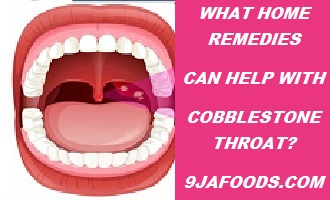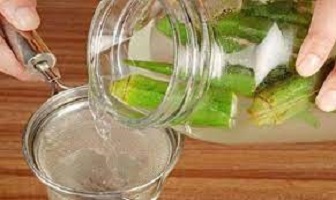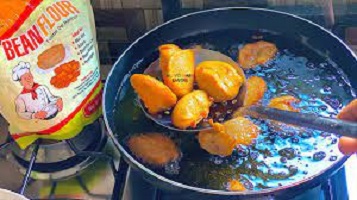Cobblestone Throat Home Remedies for Throat Bumps
Cobblestone Throat Home Remedies for Bumps in Throat ~ What Home Remedies Can Help With Cobblestone (sore) Throat?

The name “cobblestone throat” refers to the bumps in the back of your throat that accompany this condition. The pebble-like bumps appear to be larger than they are.
Cobblestoning of the throat is caused by throat irritation caused by postnasal drip from infections and allergic reactions. The bumps disappear once the source of the irritation is resolved.
What is cobblestone throat?
A Cobblestoning throat is an inflamed throat with visible bumps and lumps in the back. The pimples are caused by enlarged lymphatic tissue in the tonsils and adenoids, which are tissue pockets in the back of your throat.
This is a bothersome condition that can cause irritation.
Cobblestoning in the throat is characterized by inflamed tissue in the back of the throat that appears bumpy.
Many people become concerned when they notice raised tissue, believing that the bumps are cancerous growths. However, the bumps are not dangerous.
The “cobblestones” you see in the mirror are fluid-filled tissue that forms in response to an infection, allergen (something to which you are allergic), or other irritants.
Fortunately, a healthy immune system is effective at eliminating germs or irritants that cause cobblestones in the throat. When the underlying cause is resolved, the bumps disappear.
Let’s look at what causes throat cobblestoning and what home remedies can help you get rid of it.
Why Do Cobblestone Lumps Form in Your Throat?
According to research, polygonal cells protrude from the throat walls, resembling cobblestones which are bumpy.
Cobblestone throat can be caused by a variety of factors. Here’s a list of some of them:
- Bacteria and viruses
- Post-Nasal Mucus
- Allergy
- Irritants
- Acidic Stomach
Cobblestone Throat Symptoms: How Does It Feel?
A cobblestone throat has a pebble-like appearance, as the name implies. You may also notice: depending on what’s causing it
- A persistent dry cough
- Feeling like you need to clear your throat all the time
- Feeling like something is stuck in your throat?
- Hoarseness
- Poor breath
- Stuffiness
- Fever
- Pain when you talk
- Pain when you swallow.
- A scratchy or tickly throat.
- A sore throat
- Nausea and bad breath
What causes cobblestone throat?
When your tonsils and adenoids become irritated and swollen, bumps appear.
Tonsils are a pair of soft tissues in the back of your throat. The adenoids are soft tissue patches located high in the nasal cavity behind your nose.
Your tonsils and adenoids keep germs out of your respiratory tract. Mucus coats these tissues and your passageways, trapping germs even more.
Invaders such as viruses can sometimes get past these defenses and trigger your body’s immune response.
When this happens, your throat tissue swells, and your mucus production increases.
The increased mucus aids in the removal of germs. The mucus thickens and drips down your throat, irritating your tonsils and adenoids.
This irritation is reflected in the bumps in your throat.
Cobblestone throat can occur as a result of:
- A cold.
- Influenza
- Allergies
- Acid reflux
- Inhaling dry air.
- Using tobacco or vaping.
- Additional upper respiratory infections.
What Are the Cobblestone Throat Treatment Options?
The source of the problem determines the treatment for cobblestones in the throat:
- Antibiotics: If an infection causes bacteria to form cobblestones in the neck area.
- Decongestants may be an effective treatment option for people who suffer from nasal congestion and cobblestone throat.
- Antihistamines: when allergies are the source of your problem
- Nasal Spray: Steroid nasal sprays can be used to treat a cobblestone-like throat caused by an allergy.
How to Treat Cobblestone Throat at Home: Home Remedies for Cobblestone Throat
Many home remedies can help relieve sore throat symptoms and reduce swelling and bumps.
Among these remedies are:
- Gargle with salt water
Gargling with warm salt water may help clear throat mucus and relieve cobblestone throat symptoms.
- Drink Turmeric Milk
- Drink Chicken Soup
- Suck on Lozenges
- Use a Throat Numbing Spray
- Use Some Honey
- Sleep upright
- Take Apple Cider Vinegar
- Suck a Piece of Garlic
Prevention
How can I lower my risk?
Consider the following precautions to avoid cobblestone throat:
- Recognize and avoid substances that aggravate your allergies.
- Do not smoke, vape, or be exposed to secondhand smoke.
- Maintain a healthy lifestyle that includes eating a nutritious diet, exercising, getting enough sleep (seven to eight hours per night), and avoiding stress.
- Avoid bacterial and viral infections by avoiding physical contact with sick people, masking or social distancing as needed, and frequently washing your hands.
Takeaway!
The back of the throat can be frightening in the case of chronic cobblestone throat. However, most people’s symptoms will fade over time if they are not treated.
Because infants and young children are predisposed to cobblestone throat infection, any unusual symptoms, such as bumps on the back of the throat, should be reported to a doctor.
Anyone who is unsure what to do should consult a doctor.
People also ask
Will cobblestone throat go away?
In most cases, your cobblestone throat will resolve without treatment.
You can also try natural remedies to alleviate your symptoms and reduce throat pain and irritation.
However, if your condition worsens, you should consider seeing an ENT Specialist.
What causes throat cobblestoning?
Cobblestone throat is usually caused by postnasal drip, which is extra mucus dripping down the back of your throat.
The glands in your nose and throat produce mucus.
It helps to moisten dry air, clean your nasal passages, trap harmful pathogens, and prevent the inhalation of foreign materials.
Is Cobblestone throat a cause for concern?
You may experience a sore throat, hoarse voice, difficulty swallowing, running nose, or nasal congestion if you have a cobblestone throat.
Contact a doctor if these symptoms persist for more than a week or worsen.
Is salt water beneficial for cobblestone throat?
Although saltwater will not cure a sore throat, it will help to relieve pain and discomfort.
This is due to saltwater’s hypertonic properties, which means that the osmotic pressure in salt water is greater than the pressure in the fluid surrounding the cells.
Is gargling salt water beneficial for cobblestone throat?
There is scientific evidence to support the purported medicinal benefits of saltwater.
It won’t cure a sore throat; only time will do that, but its hypertonic properties (a biological term indicating that the osmotic pressure in the surrounding fluid is higher than that in the surrounding fluid) can help relieve pain and inflammation.
How painful is cobblestone throat?
Pharyngitis, also known as acute pharyngitis and cobblestone throat, is an inflammation of the back of the throat, also known as the pharynx.
In general, the condition causes pain and a scratchy sensation in the throat region, as well as difficulty swallowing
Does hot tea help cobblestone throat?
If you have a sore throat, a warm cup of tea may help relieve it. Gargling cool tea may also help provide relief in some cases.
Is ice cream good for Cobblestone throat?
Extra crushed ice will help to soothe your throat even more.
According to Dr. Favini, cold foods such as ice cream “can be especially good because they help soothe the sore throat and may even reduce the inflammation.”
Just be careful not to overdo it on the sugar.
Is ibuprofen effective for cobblestone throat?
To treat pain and swelling, over-the-counter (OTC) pain relievers such as Tylenol (acetaminophen), Advil, or Motrin (ibuprofen) may be used.
Is Cobblestone throat a viral or bacterial infection?
The most common cause of a cobblestone throat is pharyngitis, which causes the throat to become swollen, painful, and irritated.
Pharyngitis can be caused by a variety of conditions, but it is most commonly caused by a viral or bacterial infection, such as the flu or a common cold.
What should you avoid drinking if you have a sore throat?
Avoid caffeine and alcohol.
Alcohol and caffeinated beverages, such as coffee, are diuretics, which means they can dehydrate you.
As a result, your throat may become irritated and, in extreme cases, sore.
Consider avoiding these beverages or substituting beverages with lower alcohol or caffeine content.
What drinks aggravate sore throats?
Citrus fruits and juices include: When suffering from a cold, many people turn to orange juice as a source of vitamin C.
Citrus juices, on the other hand, can aggravate sore throats due to their acidity.
As a result, they may irritate the already sensitive surface of the throat.
What fruit can help with a sore throat?
Smoothies made with low-sugar, high-antioxidant ingredients like berries, kale, or celery soothe the throat while also boosting the immune system.
Add fruits like oranges or tangerines to boost your Vitamin C levels and speed up your recovery.
Cobblestone throat treatment at home ~ what home remedies can help with cobblestone throat?
- Drink plenty of warm fluids: Warm liquids, such as soup or tea, can thin mucus and soothe your throat.
- Gargle with warm salt water: The combination of warm water and salt can thin your mucus and filter out some allergens (pollen, dust, mold, etc.)
Is it possible for cobblestone throat to go away on its own?
In most cases, your cobblestone throat will resolve without treatment.
You can also try natural remedies to alleviate your symptoms and reduce throat pain and irritation.
If your condition worsens, you should schedule an appointment with an ENT Specialist
How to treat cobblestone throat
Cobblestone throat can be treated in several ways, including:
- Using antibiotics to treat bacterial infections.
- Avoiding allergens that activate your immune system.
- Using OTC steroid nasal sprays, non-drowsy antihistamines, and decongestants to thin the excess mucus that is irritating your throat.
Is cobblestone throat harmful?
Cobblestone throat is characterized by inflamed tissue in the back of the throat that appears bumpy.
Many people become concerned when they notice raised tissue, believing that the bumps are cancerous growths.
However, the bumps are not dangerous.
Can you live with cobblestone throat?
Although bumps in the back of the throat can be uncomfortable, they are rarely causing concern.
In most cases, your cobblestone throat will resolve without treatment. You can also try natural remedies to alleviate your symptoms and reduce throat pain and irritation.
Causes of Cobblestone Throat
Cobblestone throat is caused by throat irritation caused by postnasal drip from infections and allergic reactions.
The bumps disappear once the source of the irritation is resolved.
What are the symptoms of cobblestone throat? How do I know if I have cobblestone throat?
You may experience a sore throat, hoarse voice, difficulty swallowing, running nose, or nasal congestion if you have a cobblestone throat.
Contact a doctor if these symptoms persist for more than a week or worsen.
Cobblestone Throat Pictures ~ what does cobblestone throat look like?
What exactly are the signs and symptoms of cobblestoning throat?
The primary symptom of cobblestone throat is obvious from the name: bumps in the back of your throat that resemble cobblestones or pebbles.
The bumps could appear red, irritated, or inflamed. You’ll almost certainly have a sore throat (pharyngitis).
What STDs are responsible for cobblestone throat?
Chlamydia is a sexually transmitted infection (STI) that typically affects the vaginal, penis, and anus mucous membranes.
It can, however, occasionally infect the mucous membranes of the throat.
Pin it to Pinterest In some cases of chlamydia, a person may experience throat redness and soreness.
How long does it take for cobblestoning the throat to heal?
Cobblestoning in the throat usually goes away on its own after about a week. If it does not, consult your doctor
They can assist you in determining the source of your cobblestone throat and recommending treatments.
How do I remove the cobblestone from my throat?
To treat a cobblestoning in the throat, you must first treat the mucus-producing condition that caused it to appear in the first place.
Over-the-counter decongestants, such as pseudoephedrine (Sudafed), can help break up extra mucus caused by allergies or infections.
Antihistamines can also be beneficial.
Symptoms of cobblestone throat

What exactly are the signs and symptoms of cobblestoning throat?
- Dry cough.
- Hoarseness
- Bad breath.
- Stuffiness
- fever
- Pain when you talk.
- Pain when you swallow.
- A scratchy or tickly throat.


